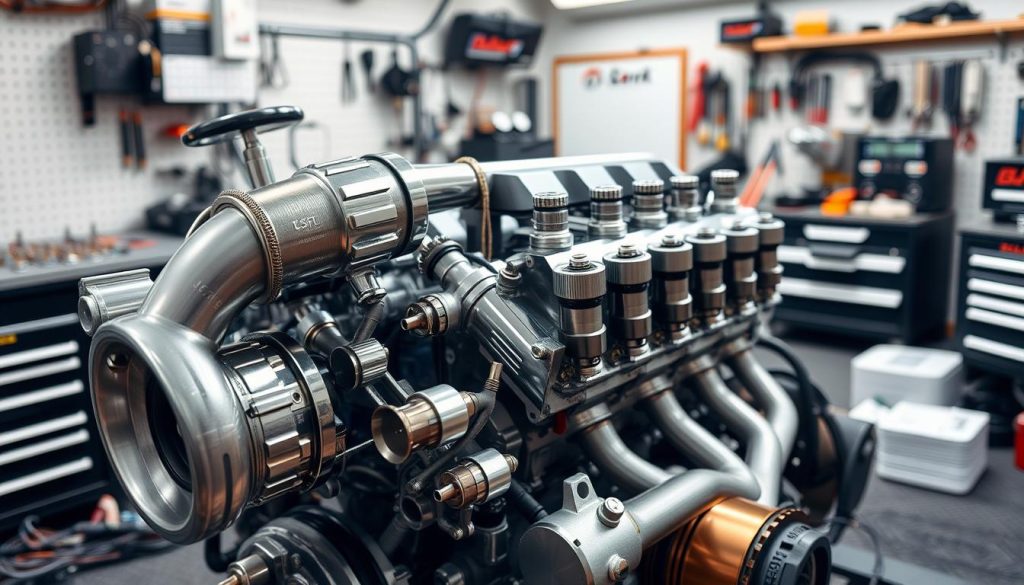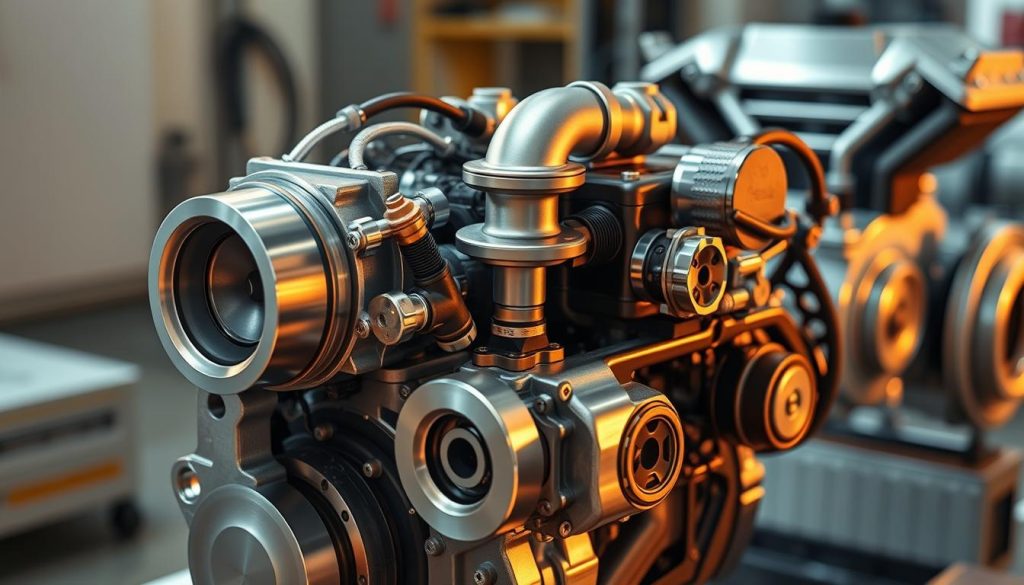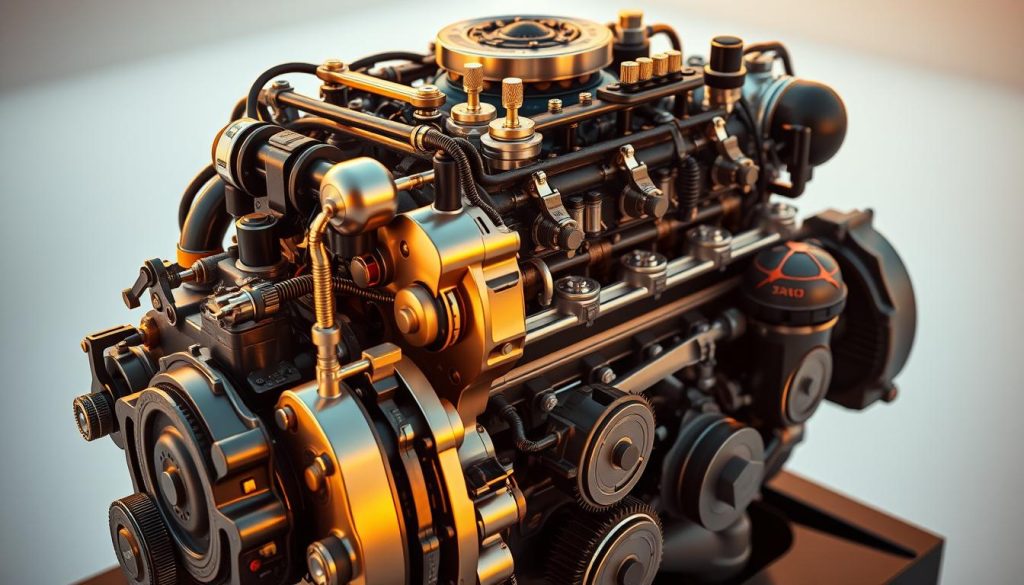Engines turn heat energy into motion, but most lose 75% of fuel’s power. Only 25% of combustion energy moves your vehicle. Proper optimization can recover lost power, boosting performance and extending motor life.
Synthetic lubricants reduce friction, making engines more efficient. Upgrades like high-performance throttle bodies add 10-20 horsepower. Even small changes, like proper fuel line sizing (3/8-inch for most motors, 7/16-inch for over 500 hp), improve fuel flow and power delivery.
Key Takeaways
- Engines waste 70-75% of heat energy, with only 25% used for propulsion.
- Synthetic lubricants cut friction, boosting engine lifespan and high-heat performance.
- Proper fuel line sizing prevents power loss in high-performance applications.
- Superchargers can add 50-200 hp, while cold air intakes increase air density for better combustion.
- Regular maintenance, like checking ignition timing and filters, prevents power-robbing issues.
Understanding Your Engine’s Fundamentals
Every vehicle needs a complex machinery to turn fuel into motion. At its heart, your engine mixes air and fuel, ignites it, and turns that energy into power. Let’s explore how this magic happens.
How Different Engine Types Work
Engines come in various shapes and fuel types. Here’s a quick look at the differences:
| Type | Description |
|---|---|
| Inline | Cylinders in a straight line, found in small cars. |
| V-type | Cylinders split into two banks, balancing power and space. |
| Boxer | Opposing cylinders for a low center of gravity, in sports cars. |
| Rotary | Uses a triangular rotor instead of pistons, like in the Mazda RX-8. |
Key Components That Affect Performance
Key parts that boost efficiency include:
- Intake/exhaust systems: Ensure the best airflow for combustion.
- Pistons/rings: Seal cylinders to keep power in.
- Valve train: Controls air/fuel mixture flow and timing.
Common Engine Terminology Explained
Let’s decode important terms:
“Horsepower measures peak power, while torque defines pulling force at lower speeds.”
- Compression ratio: How much air/fuel is compressed before ignition.
- Displacement: The total volume of all cylinders.
- Redline: The maximum safe RPM before engine damage.
Signs Your Engine Needs Optimization
Small changes in your car’s performance might mean your engine needs help. Look out for signs like lower fuel efficiency, strange noises, or warning lights. These are hints that your engine isn’t working its best.
- Lower Gas Mileage: If your gas tank lasts 10-15% less, it could mean clogged filters or poor combustion. Regular oil changes every 3,000-5,000 miles can help.
- Unusual Exhaust Smoke: Blue smoke means oil is burning, while black smoke suggests too much fuel. Both are signs of a power plant imbalance that needs checking.
- Noises and Vibrations: Sounds like ticking, knocking, or grinding often mean worn parts like valves, pistons, or bearings. Ignoring these can lead to expensive fixes.
- Check Engine Light: This light warns you of problems like misfires or sensor issues. Fixing these early can prevent bigger damage.
Slow acceleration or rough idling might mean dirty fuel injectors or timing problems. Modern engines use sensors and the ECU to check performance. But, physical signs are also important. Waiting too long to fix issues can cost a lot—up to $800 for stalling problems. Regular checks and quick fixes keep your engine running smoothly and efficiently.
Essential Maintenance Practices for Engine Longevity
Regular upkeep keeps your engine running smoothly and extends its lifespan. Neglecting maintenance leads to costly repairs and reduced performance. Let’s explore the steps to protect your engine’s delicate contraption and apparatus.
A clean air filter can boost fuel efficiency by up to 10%. Regular checks save money and prevent engine strain.
Regular Fluid Checks and Changes
Oil lubricates moving parts, reducing friction. Change it every 5,000 to 7,500 miles to maintain optimal viscosity. Use the right oil type (synthetic or conventional) as specified in your manual. Coolant prevents overheating—replace it every 30,000 miles to avoid corrosion in your engine’s cooling apparatus.
Filter Replacement Schedules
- Air filters: Replace every 12,000 to 15,000 miles to ensure proper airflow and combustion.
- Oil filters: Change with every oil service to trap debris and protect internal components.
- Fuel filters: Clean or replace them every 20,000 miles to prevent clogs and maintain fuel flow.
Belt and Hose Inspections
Check drive belts and coolant hoses every 6 months for cracks or wear. Replace timing belts between 60,000 to 100,000 miles to avoid catastrophic failure. A failing belt or hose could damage your engine’s critical apparatus.
Spark Plug Maintenance
Spark plugs ignite fuel, so check them every 30,000 miles. Replace them if electrodes are worn to prevent misfires. Proper gaps ensure efficient combustion, boosting fuel economy by up to 2% to 3%.
Maintaining these practices protects your engine’s delicate contraption. Follow manufacturer guidelines and schedule professional inspections to catch issues early.
Advanced Engine Tuning Techniques
Mastering advanced engine tuning needs precise tools and skill. Modern engine tuning uses special equipment like dynos and ECU software. These tools help unlock your vehicle’s hidden performance.
“Proper calibration ensures 5-15% gains in horsepower and torque through precise air/fuel balancing.”
Electronic Control Unit (ECU) Adjustments
- Professional tuners use dynos like the Stuska to map parameters like ignition timing and fuel trims
- Advanced courses like Tuner School’s TS201 (28 lecture hours) teach ECU reprogramming basics
Air/Fuel Ratio Optimization
| Condition | Optimal Ratio |
|---|---|
| High Load | 12.5:1 to 13.5:1 |
| Idle | 14.7:1 (stoichiometric balance) |
Timing Adjustments for Maximum Power
Proper ignition timing requires:
- Starting with factory specs for baseline mapping
- Making adjustments in 2° increments
- Testing with a dyno
Professional programs like Tuner School’s curriculum (315 total hours) teach these skills. They focus on lab work and real-world use. Always remember, tuning wrong can void warranties and damage your engine. Certified techs use special equipment for safe, reliable results.
Choosing the Right Products for Your Engine
Protecting your motor and machinery starts with picking the right lubricants and fuels. Synthetic oils like Mobil 1 outperform conventional oils, reducing friction in high-heat environments. Full-synthetic options, such as those from Quicksilver, offer longer-lasting protection for engines in demanding conditions.
“The right oil extends engine life by maintaining critical tolerances under stress,” says industry research.
Oil types vary by need: full-synthetic oils suit high-performance vehicles, while synthetic blends balance cost and performance. Mineral oils work well in older engines or light-duty machinery. Check viscosity ratings like 0W-40—lower numbers like 5W-30 are ideal for modern engines to reduce startup friction.
- Synthetic oils resist thermal breakdown in machinery used in mining or farming.
- Full-synthetic options like Mobil 1 0W-40 meet API and ACEA standards for precision.
- Quicksilver’s synthetic blends cut wear by 20% compared to mineral oils in harsh conditions.
When choosing fuel, match octane ratings to your engine’s design. High-compression motors need premium fuel to prevent knocking. Avoid additives marketed for “engine cleaning” unless they’re backed by brands like Quicksilver, proven to reduce sludge without damaging seals.
For machinery in extreme heat, full-synthetic oils protect better than mineral oils. Always check OEM recommendations—Mercedes AMG and McLaren specify low-viscosity synthetics for their engines. Proper product selection ensures your motor runs smoothly and machinery lasts longer.
Upgrading Components for Enhanced Engine Performance
To get the most out of your engine, you might need to upgrade some parts. Each change aims to fix specific issues, making your engine more powerful and efficient. Before making any changes, check if they fit your engine and consider your budget and skill level.

Air Intake Systems
Cold air intakes swap out the factory system for better airflow. They draw in cooler, denser air, which helps your engine burn fuel more efficiently. Adding a velocity stack, a special device, can further improve airflow with high-flow filters. Prices start at $40 and can boost your engine’s power by 5–20 horsepower. Plus, using washable, reusable filters saves money in the long run.
Exhaust System Modifications
Performance exhaust systems help by reducing backpressure. They do this by widening the pipes and replacing old catalytic converters. Headers and free-flow mufflers also play a role, making your engine respond faster and adding 10–25 horsepower.
Turbochargers and Superchargers
Forced induction mechanisms like turbochargers use exhaust gases, while superchargers are belt-driven compressors. Superchargers give you instant power, spinning up to 50,000 RPM. But, they might need cooling system upgrades. Turbochargers, on the other hand, can increase horsepower by 50% but might need intercoolers to handle the heat.
Internal Component Upgrades
Internal upgrades include changing camshafts for better valve timing and porting cylinder heads for improved airflow. Upgrading ignition coils also helps with stronger sparks. These changes need to be done carefully; swapping camshafts alone can boost horsepower by 15–30. Make sure to pair these upgrades with the right fuel injectors and ECU tuning.
Temperature Management: Keeping Your Engine Cool
Keeping your engine at the right temperature is essential. Most engines work best between 190–220°F (87–104°C). If it gets too hot, it can damage parts. If it’s too cold, it won’t run well.
Your cooling system is a complex setup. It includes the radiator, thermostat, and coolant. If the thermostat doesn’t work right, it can stress your engine.
Synthetic oils like Mobil 1 help your engine handle high heat. They prevent damage during stressful times. Radiators and fans work better now, cooling your engine faster.
Modern engines use smart systems to keep cool. These systems use computers to improve performance and save fuel.
- Check coolant levels every 3 months
- Replace coolant every 30,000 miles
- Use a 50/50 coolant mix for corrosion protection
Engines with forced induction need coolers for intake air. This increases power. But, if they don’t cool well, your engine loses power.
Old coolant can cause corrosion. Replacing it keeps your engine running smoothly. Electric fans and better radiators help keep your engine cool. This helps it last longer and run better.
Fuel Efficiency Tips for Modern Engines

Modern engines need precise apparatus and equipment to be both powerful and efficient. Making small changes in how you drive and maintain your car can save a lot of fuel. Here’s how you can do it.
Driving Habits That Save Fuel
- Smooth acceleration reduces strain on the engine and cuts fuel waste.
- Use cruise control on highways to maintain steady speeds and avoid unnecessary throttle spikes.
- Limit idling—turn off the engine if stopped for more than a minute.
Maintenance Practices That Improve Efficiency
Regular checks with proper equipment ensure optimal performance:
- Check tire pressure monthly; underinflated tires reduce mileage by up to 3% (U.S. Department of Energy).
- Clean air filters to prevent the engine from working harder to draw air.
- Remove roof racks or cargo when unused to cut drag.
Technology Solutions for Better Mileage
Modern apparatus like start-stop systems and cylinder deactivation optimize fuel use. Newer engines with ECU tuning can adjust air/fuel ratios for peak efficiency. Hybrid systems recover energy during braking, boosting overall mileage.
“A properly tuned engine can improve efficiency by 4% just by fixing vacuum leaks.”
By combining these strategies, your engine will run efficiently without losing power. Focus on driving smoothly, stay proactive with maintenance, and use tech designed to reduce fuel consumption.
Conclusion: Maintaining Peak Engine Performance for Years to Come
Your engine’s life depends on regular care, upgrades, and smart driving. Regular oil changes, every 3,000 to 10,000 miles, are key. Using products like Rislone’s Engine Oil Supplement helps protect vital parts. This can extend your engine’s life by up to 50%, making it last over 200,000 miles.
Keep an eye on your engine’s performance, like fuel efficiency and compression levels. Rislone’s Compression Repair With Ring Seal keeps compression at its best, boosting horsepower. Even older engines can benefit from treatments like High-Mileage Formula, which reduces wear and boosts power. Checking belts every oil change can prevent 15% of breakdowns caused by neglected parts.
Even hybrid and electric vehicles need basic engine care. Regular coolant flushes and fuel injector cleaning are essential for all engines. The 1876 Otto Cycle Engine design is old, but today’s engines need modern care.
Optimizing your engine is an ongoing process. Schedule inspections before long trips and keep track of maintenance like spark plug replacements. Rislone’s Nano Prime Oil Booster can increase horsepower and reduce wear. By following these steps, you create a long-term plan for your engine’s health. A well-cared-for engine doesn’t just last—it thrives. Stay consistent, and your engine will reward you for years to come.


